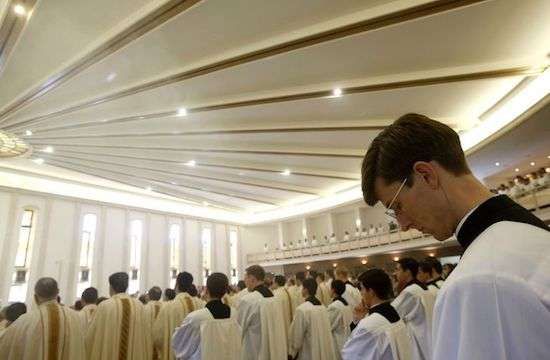(MEXICO)
La Croix International [France]
June 18, 2021
By By Diego Calmard* | Mexico
The Legionaries of Christ were supposed to be the great Catholic hope of Latin America, but their Mexican founder’s sexual crimes have permanently weakened the congregation
Father Marcial Maciel’s name no longer appears on any of its official documents.
But the Legion of Christ, the male religious congregation the late Mexican priest set up in 1941, is still deeply affected by the actions of its founder.
Maciel has been accused of some 60 rapes and other forms of corruption.
Most of his crimes came to light after his death in 2008. But they have plunged his congregation into a long crisis.
The Legion of Christ was once touted as the future of the Church in Mexico, the country with the world’s second-largest Catholic population.
But at the order’s most recent chapter, the Legionaries (as the group is more commonly known) spoke of a “vocational emergency, marked by a steady decline in new admissions”.
Ten years ago their general directory listed some 2,273 members.
Today that figure has plummeted to 1,455 members.
Located in 21 countries, the Legion has 4 bishops, 970 priests and 481 seminarians.
A third of these are in Mexico, where the number of priests remains stable at 385.
Cristian Borgono, former member and creator of the Legioleaks Facebook page, speaks of a generational gap.
“The older members remain, but there are few seminarians. The vast majority of the 300 members of the institution who left had little seniority,” he says.
Faced with this crisis, the Legion is now trying to settle the accounts of its past. At the end of March, it revealed 27 other names of priests who had sexually abused 175 minors.
Since the death of the founder, Church authorities have reached out to victims.
Archbishop Franco Coppola, the papal nuncio to Mexico, met with them in 2016 when he first arrived in the country.
He claims there have been no further abuse accusations against the Legionaries.
No longer on the rise
Regardless, the Legion is no longer on the rise within the Mexican Church.
But according to Father Ramos, a priest in Mexico City, the Episcopal Conference of Mexico — which did not wish to answer our questions — “opens its doors to all institutes and this one is no exception”.
“They are conservative, but their religious work has real value,” he says.
Archbishop Coppola agrees, pointing to the 80 high schools and universities the congregation operates.
“The Legion fulfills a fundamental mission that the Church has forgotten: the spiritual accompaniment of young people,” the nuncio notes.
Marcelo Bravo, a Legionnaire who teaches theology at the Pontifical Athenaeum Regina Apostolorum in Rome, says his order has gone where others have not.
“Cancun-Chetumal is a territory that was assigned to us in the 1960s and we have parishes there,” he says.
The territory, which was once an uninhabited area along the Caribbean coast, could soon become a diocese.
“To purify it will take time”
Bravo says the Legion still maintains its influence “through apostolic or social works and its schools”.
“The Legion is a patient on the road to recovery,” says Archbishop Coppola, offering a vote of confidence.
The congregation recently issued a report called “Truth, Justice and Healing” as an act of repentance.
But all is not well.
“The new director of the Legionaries in Mexico and Central America, Father Alberto Siman, is facing resistance internally,” laments the papal nuncio.
Can the crisis be overcome?
Borgono, a former Legionnaire, is cautious.
“It will take time to purify the organization,” he says. “We must not forget that Father Siman and other current leaders were close to the founder.”
Alberto Athié, a former priest and co-author of the book La volundad de no saber (The Will Not to Know), says the Legion’s latest report “reflects above all the institution’s fear of losing its benefactors”.
Among the Mexican elite
The Legion of Christ has gained influence among Mexico’s small elite.
Marta Sahagun, the wife of former president Vicente Fox (2000-2006), has been an ardent supporter.
“They had created the Club of Rome, a sort of fifth column infiltrated by the media and the political and economic powers,” says Bernardo Barranco, a sociologist of religions.
In fact, Maciel was the priest who officiated at the wedding of Carlos Slim, the Mexican media magnate who was once believed to be the world’s richest man.
Anahuac University, located in the upscale suburbs of Mexico City, is known as the Legion’s flagship institution.
It’s more renowned for its list of prominent alumni than for its academic excellence, which has allowed the religious congregation to maintain its position among the elite.
But the closing of several schools shows the decline of the Legion’s influence in Mexico.
“The Legionaries had two goals: to be a machine for training priests and to make money,” says Roberto Blancarte, a Mexico’s former ambassador to the Holy See.
Its acquired wealth, estimated at billions of dollars, continues to taint the institution
.José Barba, who was molested by Maciel while in seminary, says flatly: “It will be difficult to rescue the organization from its current ethical and moral framework.”
(The Legionaries of Mexico declined to comment for this story.)

Read more at: https://international.la-croix.com/news/religion/scandals-have-weakened-the-legionaries-of-christ-in-mexico/14492
